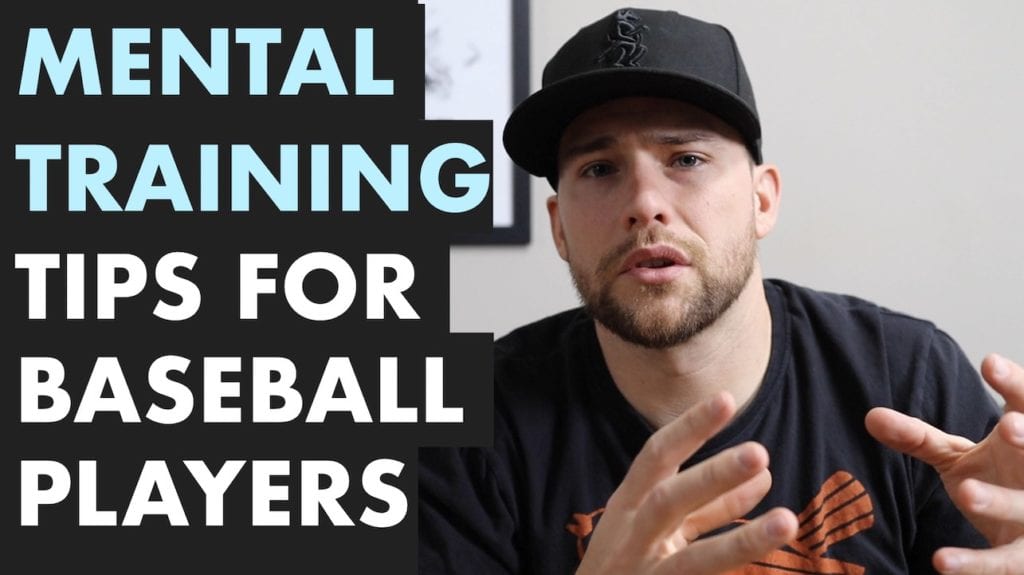*This article may contain product links which pay me a small commission if you make a purchase. Learn more.
For baseball players, mental training is absolutely critical. With so much time between plays, the mind has ample opportunities to wander and hurt a player’s performance. The “time gap” in sports is very difficult to manage, as an empty mind allows the best opportunity for fluid action in a game. Learn four crucial mental skills training concepts in this article to help manage your mind as a baseball player.
Why Is Mental Skills Training Important?
Today we’ll tackle the following four problems and concepts in mental skills training:
- How Pressure and time-gaps kill performance
- Doubt and the fear of failure make an athlete hesitate
- Uncontrollable outcomes and luck cause frustration
- Negative Self-Talk and how to improve on it
#1: Pressure & Time-Gaps in Baseball

What is Pressure, anyway?
Pressure is one’s perception of the stakes involved in a situation – the possible good and bad consequences that come from potential outcomes. But, we know this right? We all intuitively know what pressure feels like and where it comes from.
The Time Gap in Baseball
Baseball is a big time-gap sport, in which players have lots of time to think between plays. This thinking is what allows them to internalize pressure, frustrations, excitement, fear, etc. – both positive and negative emotions and perceptions of the situation.
BUT.
Athletes play best when they don’t think. Playing with fluid action–letting the body do what it has practiced to do without any hesitation whatsoever–is how champions turn in their best performances.
The time-gap kills this, because when we think about what might happen, we start to attempt to control the outcome, which means we try to consciously control our bodies. It’s counter-productive.
Combating The Time Gap
Our goal as athletes is to return to a “present” state of mind, where are not looking ahead or behind us. Consequences live only in the past and only in the present, so when we stay present and just try to accomplish the task at hand (hitting the ball where it’s pitched, for example) we are better able to succeed.
Mental skills training for baseball players is crucial in building armor against time gaps and our response to them.
Watch The Video Below for More on Staying Present in the Time-Gap.
#2. Doubt & Fear of Failure
When we’re in a time-gap, the fear of failure creeps in. The voice of that little jerk sitting on our shoulder starts getting louder, telling us that we can’t. Fear of failure stops athletes in their tracks, because they’re so concerned with not screwing up (they’ll look stupid, hurt the team, embarrass themselves and others, etc.) that they hesitate and can’t execute with the skills they already have.
Think about walking on a curb – you could easily walk toe to toe on a curb without falling off for as long as you probably wanted, right? It takes some balance, but not a tremendous amount.

But if you try to walk a balance beam of the exact same width, shape and texture as a curb on the ground, only it’s 50 feet off the ground…your balance gets pretty shaky, doesn’t it?
The only difference (ignoring wind) is that the fear of falling off–the fear of failure and consequences of that failure–causes your brain to try to intervene, try harder to not fall, and by trying harder inspires shakier balance. It’s an inverse relationship – the harder an athlete tries, the worse he or she does.
How to Combat The Fear of Failure
One way seems counterintuitive, but it was used with great success by Samurai warriors for centuries: they would meditate on their own deaths (their version of failure, since failing in combat meant death).
Why did they do this? When they had visualize themselves dying in combat so many times, they grew…used to it. They stopped fearing it because they’d visualized it happening so many times. This freed them from the fear and allowed them to fight with clear minds, which actually helped them be better swordsman. Watch the video below for more on this tactic and how it can apply to baseball.
#3. Uncontrollable Outcomes
Baseball is one of the WORST sports for uncontrollable outcomes.
In boxing, if you get punched in the face…it’s your own fault.
In swimming, if you don’t want to lose you should swim faster.
But in baseball, you can smoke a pitch right into a fielder’s glove. Pitchers can make a great pitch in a tight spot only for a hitter to break his bat on a game-winning blooper. Good and bad luck happens a LOT.
Frustration Kills the Next Play.
Frustration takes a player out of the present moment, out of an attempt to do his job with a singular focus. Frustration time warps a player into the past, where he’s stuck being angry and emotional about ways he got screwed despite doing everything right.
In the end, we can only control so much. A good way to think about baseball is through a percentage-focused mindset. Watch the video below for more detail on why hitters and pitchers alike should think in percentages rather than absolutes.
Mental Skills Technique: Think in Percentages.
#4. The Power of Self Talk
Self talk: the inner dialogue between you and yourself.
The problem is that much of our inner dialogue is mean, rude and no good. Why do we say such hateful, harsh things to ourselves? Why do we tell ourselves that we can’t?
The reality is that we all doubt ourselves, even as we are performing well and have turned in long histories of good performance and success. So, we have to re-wire our circuitry and start producing positive self-talk on the baseball field and in everyday life. We have to drown out that negative, hateful voice with confidence.
Learn how to do this in the video below.
Did You Learn Something?
Hopefully this article gave you a lot to think about. If you struggle with the mental side of baseball as a player, definitely spend some time on this page and my YouTube channel.
The Next Step?

My Mental skills course, The Resolute Athlete, is a great tool to help you make longterm, permanent changes in your mindset as an athlete. It was created for athletes of all sports and is perfect for teams to take together. It’s 40 videos and seven worksheets designed to teach you everything you need to be great on the field.
Make this next season your best yet! Dan Blewett
